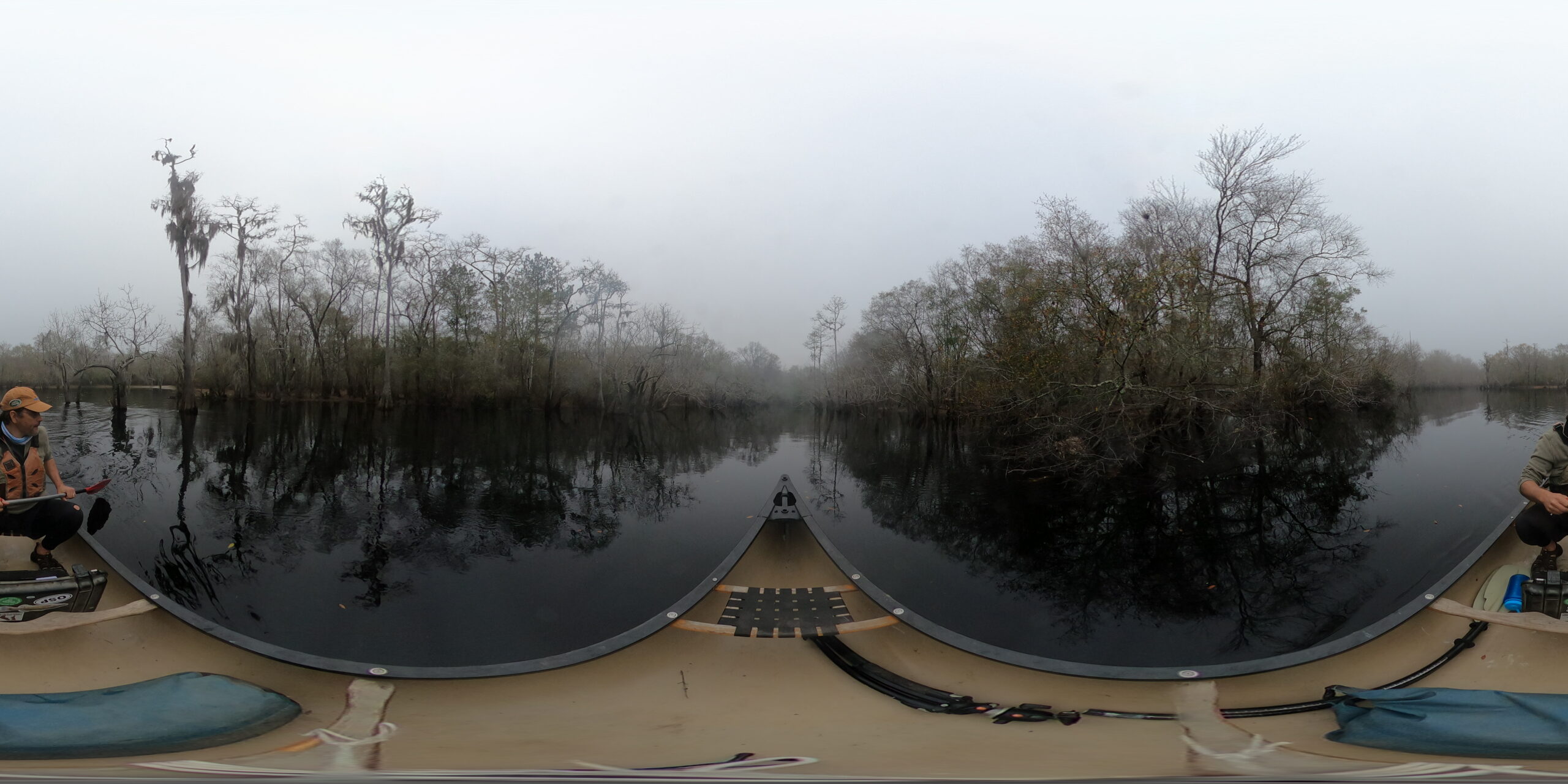Introduction
The Okefenokee Swamp – isn’t that a fun name to say? But as much as it might make you giggle, this incredible wetland is no laughing matter. It’s a unique and diverse ecosystem, spanning across southeastern Georgia and northern Florida, and it is home to a variety of rare and endangered species. You might not have heard of them all, but trust us, they’re pretty damn cool. Many of these species have critically low populations and could even face extinction in the near future, depriving us of creatures that we lived along with for time immemorable. Moreover, the swamp is considered a sacred area by multiple Native American Cultures, and its beauty draws many tourists to hiking, camping, fishing, and wildlife viewing. You can even take a virtual version of the famous boat tours using our site!
From its rich history to the inspiring conservation efforts currently underway, there’s so much to discover about this unique and ecologically diverse area. And that’s why conservation efforts in the Okefenokee Swamp are so important – to protect not just the famous animals and tourist spots but all the unique species that call this place home and the many histories that live on here.
With our maps, you can virtually kayak through the greenery, getting a close-up look at the swamp’s many wonders while learning about the critical conservation efforts aimed at preserving this vital habitat. So let’s dive in and explore everything the Okefenokee has to offer!
Ecology and biodiversity overview
The Okefenokee Swamp is a vast wetland ecosystem spanning over 400,000 acres of protected land. The swamp is a critical habitat for a diverse range of wildlife, including some of the most iconic and majestic creatures in the southeastern United States. The American alligator is one of the most well-known inhabitants of the swamp, with an estimated population of around 12,000 individuals. These apex predators can grow up to 14 feet in length and weigh up to 1,000 pounds, making them a formidable force in the swamp’s ecosystem.
Another prominent resident of the swamp is the black bear. Despite their name, these bears can range in color from black to brown or even blonde (talk about poor name choices), and they are found throughout the eastern United States. The Okefenokee Swamp is home to a population of roughly 200-300 black bears, making it one of the largest remaining bear populations in the southeastern U.S.
In addition to this charismatic megafauna, the Okefenokee Swamp is also home to a wide variety of bird species, including the endangered red-cockaded woodpecker (stop giggling, this is important). This species is unique in that it nests in live pine trees and is dependent on mature, old-growth forests for its survival. Unfortunately, habitat loss and fragmentation have led to a decline in the red-cockaded woodpecker’s population, making conservation efforts in the Okefenokee Swamp, one of its last refuges, all the more important.
The Okefenokee Swamp is also home to several rare plant species, including the Okefenokee gooseberry. This plant is found only in the swamp and is considered endangered due to habitat loss and other threats. The swamp is also home to several species of carnivorous plants, including the Venus flytrap, which captures insects using its modified leaves (did you even know the traps are technically leaves?).
So, with all this beauty and biodiversity, how did this pristine spot come under threat?
History
To understand the current challenges it faces, we need to look into Okefenokee Swamp’s long and rich history, dating back thousands of years to when Native Americans first inhabited the region. These early inhabitants relied heavily on the swamp’s resources, including fish, game, and a variety of plants used for food, medicine, and other purposes. The swamp was also an important source of water for the tribes living in the surrounding areas.
The name “Okefenokee” comes from the Creek Indian word “Okinofski,” which means “trembling earth.” This likely refers to the swamp’s unstable terrain, which is made up of peat and other organic materials that can shift and tremble underfoot. The Creek and Seminole tribes also have legends and stories about the swamp, some of which describe it as a place of spirits and ghosts.
Over time, as European settlers arrived in the region, the swamp’s resources became increasingly exploited. In the late 1800s, logging and drainage operations began in the area, leading to significant environmental degradation. By the mid-20th century, conservation efforts had begun in earnest, and in 1937, the Okefenokee Swamp was designated a National Wildlife Refuge. The Seminole Tribe of Florida, which has ancestral ties to the swamp, is still actively involved in conservation efforts, working to protect the swamp’s wildlife and restore its natural habitat. Many other organizations and grassroots groups have appeared, all united by their desire to conserve and heal this land, a veritable ecosystem of conservationists, both professionals and amateurs.
Conservation efforts
Today, the Okefenokee Swamp is protected by several organizations, including the U.S. Fish and Wildlife Service, the Georgia Department of Natural Resources, and the Okefenokee Swamp Park, as well as countless smaller volunteer groups, Native American organizations, and passionate activists. These organizations work in tandem to protect and restore the swamp’s fragile ecosystem through a variety of measures, which visitors can see firsthand on our virtual boat tour. So, what exactly is being done to achieve this?
First, because the swamp’s natural hydrology has been almost completely disrupted by past drainage operations, restoration efforts are underway to restore the swamp’s natural hydrology. This involves filling in drainage ditches and removing structures that impede water flow to restore the natural wetland. A swamp, like all wetlands, depends on having a certain amount of water available to carry out vital ecosystem functions, else everything gets out of hand, from local animals no longer being able to thrive due to changed conditions to potential wildfire risks.
Invasive plant species like the water hyacinth and hydrilla also pose a significant threat to the swamp’s ecosystem. These invasive species grow quickly and have no natural predators in the area, so they can easily choke out native plants and disrupt the natural balance of the swamp, posing a direct, serious threat to biodiversity. Efforts are underway to control these species and prevent them from spreading further using a variety of classic and novel techniques.
Fire is another critical component of the swamp’s ecosystem. Due to the disrupted hydrology and invasive species, dried up plant matter builds up dangerously fast, and the elevated temperatures can result in devastating wildfires. Prescribed burns are used to manage the swamp’s vegetation and prevent uncontrollable wildfires while recycling nutrients used up by invasive plants and other dead plants. This allows native plants to rise from the ashes of their enemies quite literally. The U.S. Fish and Wildlife Service and Georgia Department of Natural Resources work together to plan and execute prescribed burns in the swamp – so do not even think about trying this yourself!
Lastly, organizations like the Okefenokee Swamp Park work to educate visitors about the importance of the swamp and the need for conservation efforts. Through educational programs, visitors can learn about the swamp’s history, ecology, and conservation efforts. The more people understand the role of this swamp, the more opposition there will be for destructive initiatives and the more support thrown behind conservation and restoration efforts.
Conclusion
There are few places in the world like Okefenokee Swap. For many animals, it is a sanctuary, a last bastion of evolution. For some humans, it is an ancestral land that must be returned to its prime. And for hundreds of environmentalists, it is a lesson in how to manage a fragile, threatened ecosystem with many diverse stakeholders involved. Mistakes may happen as we try to restore this habitat, but as long as we keep pressing on, using all the tools and knowledge we have, and working together, we can ensure a bright future for Okefenokee.
If you enjoyed reading this article, consider visiting and enjoying the ecotourism opportunities. If you live in Florida or Georgia, you can even try getting involved with local organizations to play a role in the sustained effort for the health of the swamp. And make sure to read more blogs and explore more of our maps to see with your own eyes what’s happening in the world of conservation.


0 Comments